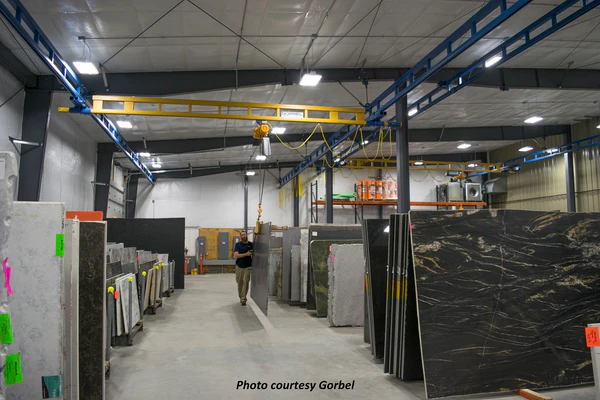
Moving a marble slab requires more than just muscle—it demands preparation, technique, and the right equipment to avoid breakage, injuries, and costly damage
Moving a marble slab requires more than just muscle—it demands preparation, technique, and the right equipment to avoid breakage, injuries, and costly damage. Whether you’re installing a new marble countertop, relocating a marble slab backsplash, or handling large panels for flooring or wall cladding, this guide will help you move your slab safely and efficiently.
With proper planning and knowledge of marble slab weight, size, and fragility, you can ensure a smooth transition from delivery to installation.

Why Marble Slabs Require Careful Handling
Marble is a natural stone known for its strength—but it’s also brittle when mishandled. Due to its size, density, and weight distribution, marble slabs are susceptible to cracking if laid flat, lifted incorrectly, or inadequately supported.
Common Risks:
- Cracking or snapping from unsupported weight
- Chipping during loading/unloading
- Surface scratches from abrasive contact
- Injury from lifting improperly or without help
👉 First, understand your material: What is a Marble Slab?

Step-by-Step Guide: How to Move a Marble Slab Safely
Step 1: Know Your Slab
Before moving anything, identify the following:
- Marble slab thickness: Most slabs are 2–3 cm thick
- Marble slab size: Can range from 4–10 feet in length
- Marble slab weight: ~13–17 lbs per square foot depending on thickness
- Type of marble: Polished, honed, or engineered
Heavy and large slabs require specialized handling, particularly Italian marble, Carrara, or Calafate which may be more fragile or valuable.
Step 2: Gather the Right Equipment
You’ll need:
- Slab dolly or A-frame cart
- Moving straps or harnesses
- Wooden A-frame for transport
- Foam or rubber padding
- Gloves (cut-resistant)
- Safety boots and back braces
- Blankets or furniture pads
- Plastic edge protectors
Optional but recommended:
- Suction lifters
- Forklift (for large commercial slabs)
Step 3: Prepare the Slab
- Clean the slab to remove dust and reduce surface abrasions.
- Use painter’s tape to secure cardboard or edge protectors.
- Wrap the entire surface in moving blankets or foam sheets.
Tip: Never stack slabs flat! Keep them upright on their edge.
Step 4: Lifting and Loading
- Always lift marble slabs vertically from the narrow edge, not flat like a tabletop.
- Lift with your legs—not your back—and work in teams.
- Position the slab on a padded A-frame rack or dolly.
- Secure it tightly using ratchet straps, but don’t overtighten (this can cause pressure cracks).
Step 5: Transporting the Marble Slab
- Place the slab edge-side down on an A-frame truck.
- Ensure the vehicle is level and the A-frame is bolted to the floor.
- Place foam padding between multiple slabs if transporting more than one.
- Use corner braces to reduce shifting.
For long trips or rough roads, check tension and support during stops.
Step 6: Unloading and Positioning
- Remove straps and supports carefully—don’t rush this step.
- Have two or more people lift and guide the slab to its new location.
- If installing right away (e.g. flooring or shower), ensure surfaces are prepped.
Need help with installation? Read:
🔗 How to Install Marble Slab Backsplash
🔗 How to Install Marble Slab Floor
Mistakes to Avoid
| Mistake | Why It’s a Problem |
|---|---|
| Laying slabs flat | Risk of snap or crack due to weight |
| Dragging on hard surfaces | Scratches and chips on polished marble |
| Over-tightening straps | Internal stress cracks, especially in natural marble slabs |
| Lifting solo | Safety hazard—always have assistance |
| Transporting without padding | Increases breakage risk during movement |
FAQs About Moving Marble Slabs
How heavy is a marble slab?
- A 3 cm thick slab weighs roughly 18 lbs per square foot.
- A full-size 6 ft × 3 ft slab can weigh over 300 lbs.
Can I move a marble slab by myself?
Not recommended. Always work with at least one other person and use proper lifting tools or dollies.
Can I transport a slab in my personal vehicle?
Only if the slab is small (like a bathroom vanity top). For full-size slabs, use a truck with an A-frame rack and tie-downs.
Related Topics You Should Know
- Marble slab cost increases dramatically if breakage occurs.
- Proper handling extends marble slab durability and resale value.
- Use marble slab edge profiles and sealing post-installation to finish the job right.
Final Thoughts
Knowing how to move a marble slab safely is just as important as installing it. Mishandling during transportation is one of the top causes of costly damage in renovation projects. With the right equipment, planning, and techniques, even large marble slabs can be transported securely to your kitchen, bathroom, or commercial space.
From polished to honed, local marble slabs to imported Italian marble, safe movement is crucial to preserving their beauty and structural integrity.

